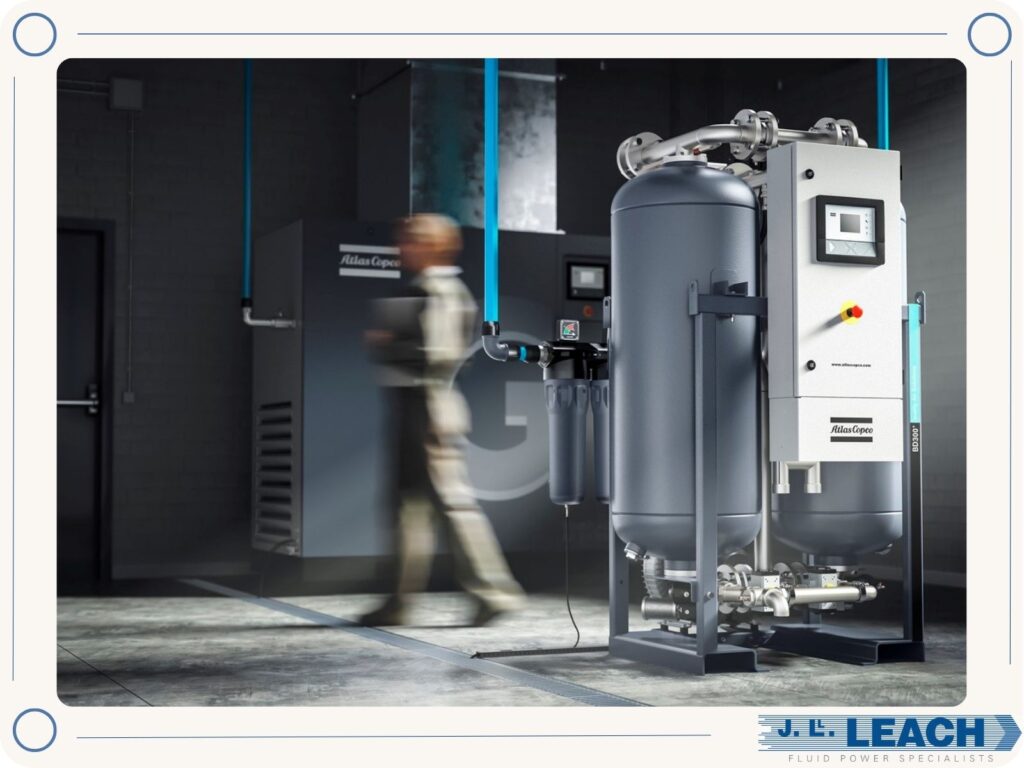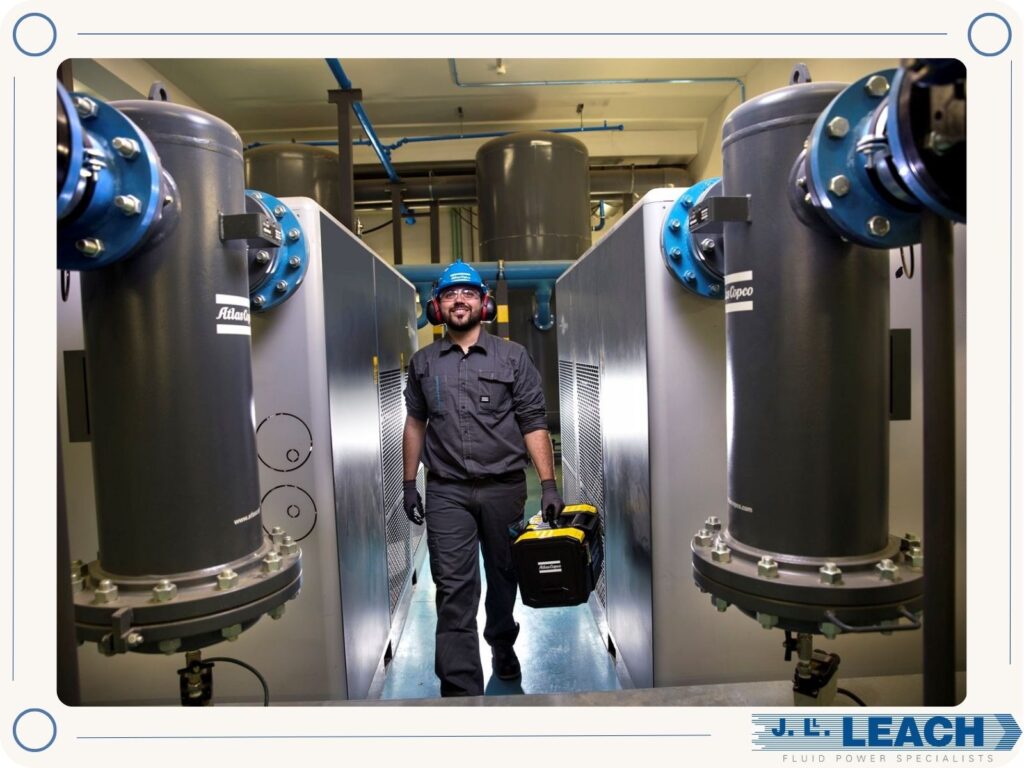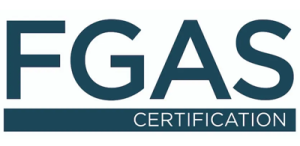Air compressors are almost everywhere. Their ubiquity is mainly a result of their versatility. You can see air compressors driving conveyors in factories and logistics hubs, enabling processes in manufacturing, generating nitrogen for industrial use, or even helping maintain the cleanliness of facilities in electronics and pharmaceutical operations as well as powering tools at roadworks.
There are few sectors that do not, somewhere, have a potential use for a compressed air system.
But much of that versatility is down to the variety of compressors. While the principle behind compressed air — essentially squeezing air into a smaller volume — is always the same, a wide range of compressors accomplish that in different ways. And the type of compressor that’s right for one setting could be entirely wrong for another. Just imagine turning up at the dentist and seeing one of those dirty roadside compressors next to the chair.
This brief guide will help you understand the complexity behind compressed air, introduce some of the different types of compressors, and start thinking about the right compressor for your needs.
Table of Contents
Understanding Air Compressors
The basic principles behind compressed air are the same, regardless of the type or the use.
Air compressor efficiency relies on the law of conservation of mass, that matter cannot be created or destroyed, only change; this applies equally to forms of energy.
With air compressors, this works by using energy to reduce the volume of air, storing it as potential energy which can be released and used elsewhere, when the air is allowed to expand again.
What differentiates air compressors, however, is how they achieve this compression, and, in turn, this affects what compressors are best for specific settings.

The ways to compress air
There are two main methods for compressing air: positive displacement and dynamic displacement.
Positive displacement compressors
Positive displacement is perhaps the most popular type of compressor. It works by drawing in air, then mechanically compressing it. The relative simplicity of these, and the degree of control over compressed air production it offers, means these are especially popular on smaller sites.
Dynamic displacement compressors
Rather than directly compressing air, dynamic displacement compressors work by increasing the velocity of the air. They draw in a large volume of air which, when accelerated, can be restricted to generate pressure. These compressors tend to be used for demanding applications requiring greater energy input.
Different types of air compressor
There are several types of air compressor that are popular. Although each will use one of the methods of air compression detailed, they all accomplish it in different ways.
Rotary screw compressor
Rotary screw air compressors feature two, interlocking, screws that turn together, trapping air between them and, as they turn, progressively compressing it. Equipped with an internal cooling system, they have high energy efficiency, are low maintenance and ideal for continuous use. They can also be oil-free, allowing them to be used when the purity of air is important, such as in food preparation or laboratory use.
Rotary vane compressors
Another type of positive displacement compressor, these feature an eccentric rotor in a chamber, with each ‘vane’ forming a seal between the intake and outlet ports. The motion of the rotor pulls air in, then compresses as it turns, expelling the compressed air through the outlet. Like the rotary screw compressor, these are good for continuous use with low maintenance, but the relatively low, inefficient output means they may not be suitable for some applications.
Reciprocating compressors
These feature a single piston, or set of pistons, to compress the air. They can be either single stage or, if more pressure is needed, multi-stage compressors. However, their design means they require oil for lubrication, which precludes them from situations where guaranteed oil-free air is needed. They are also not suited to continuous use and are more popular in workshop-type environments that need occasional, but high-pressure, compressed air.
Scroll compressors
Another positive displacement compressor, these use two interlocking scrolls that, as they move towards each other, compress air by forcing it into smaller spaces towards the centre of the scroll’s spiral orbit. The simple mechanism means they can be small, efficient compressors, often oil-free, and used in higher purity applications..
Centrifugal compressors
A type of dynamic displacement compressor, centrifugal compressors work by drawing in atmospheric air and generating kinetic energy using an impeller. The air is then slowed down using diffusers, and the kinetic energy used to compress the air. These are high output compressors, and when multi-stage compressors are used, can achieve remarkably high pressures of compressed air. As a result, they tend to be used where constant, high output compressed air is needed.
Axial compressors
Another compressor type that uses dynamic displacement, like the centrifugal compressor, axial compressors capture kinetic energy to create compressed air. As air passes through the compressor, rotors increase their velocity; meanwhile, static blades slow the air, using their speed to compress the air. They are ideal for high-volume, constant use.

Choosing an air compressor
Given the range of compressors available, it’s easy to feel the effects of a tyranny of choice. However, the characteristics of each type of compressor can help you at least narrow down which is right for you. A few simple questions are a good place to start:
What power will you need?
Perhaps the most important question that you can ask. There’s little point installing a multi-stage centrifugal compressor to power a single conveyor ! But auditing what you need your compressor to power, and what you might want a compressor to do as you grow, can help you identify both the type and model of compressors that are suitable, as well as keeping your energy costs as low as possible.
What will you use it for?
As well as helping you understand the power you need, understanding the use can help narrow down choice. Many compressors are ideal for constant running, but if your operations only need occasional compressed air, for example to power tools at specific points of a manufacturing process, then constant running may be a waste of energy, and you may want to consider reciprocating compressor options. The advent of variable speed drive, which responds to every change in demand, can generate compressed air with reduced energy consumption.
What products will you use it with?
Many air compressors are used in highly regulated sectors, like food and pharmaceuticals. In these sectors, there may be no option but to consider oil-free compressors, which can limit your choice. Even outside those regulated areas, your processes may mean you want to focus on compressors that can offer high-purity air.
Where will you use it?
Many, although not all, compressors are static. That means it’s important to think about where they will be situated. From the ambient temperature, to how staff will operate around the compressor, there is a range of factors that may attract you towards, or guide you away from, specific types of compressors.
What does the future hold?
While no-one knows for certain, it is important to think about what your business and operations might look like next year, and in five or ten-years’ time. Having thought carefully about today’s needs, buying a compressor that just meets them today might be a mistake if you need to expand tomorrow. Air compressors are adaptable, with the advent of modular pipework which allows flexibility to make future additions to your installation simple, so consider what you might need. Whether it’s an air compressor that will effortlessly help you double your output, or remote monitoring so you can shift to round-the-clock operations, you’ll be able to find compressors that are ready for that step.
Ask more questions…
Choosing the right type of compressor is a big decision, and it’s easy to be overwhelmed by the choice and information available. So, take advice, just as there are lots of compressors in use, there are lots of people who can share their experience with you. And, of course, there are air compressor specialists like J Ll Leach who’ve been installing and servicing air compressors for 4 generations and are more than happy to share the experience and expertise to help you make the right decision for your business.
The next steps
While a blog post can help you understand how compressors work and what might be right for you, it’s vital to take the time to understand them properly. While it might seem like there’s an endless choice of compressors, that’s nothing compared to the number of businesses there are, and each has their own, unique requirements.
Reading articles like this can help you understand the basics, think about the criteria that matter to you, and narrow down your choices, but they are no substitute for expert advice. Getting a consultation from experts, like the engineers at J Ll Leach, will provide a level of insight that you simply cannot get anywhere else. Whether it’s spotting issues that are specific to you, calling on our many decades of experience and knowledge to identify proven solutions, or just being able to answer simple questions you’ve not found the answers to, we are always happy to help.
Air compressors power thousands of companies in the region. And, when you get the right one, you’ll soon join them, knowing that you can rely on your compressed air, so you can focus on your business.












